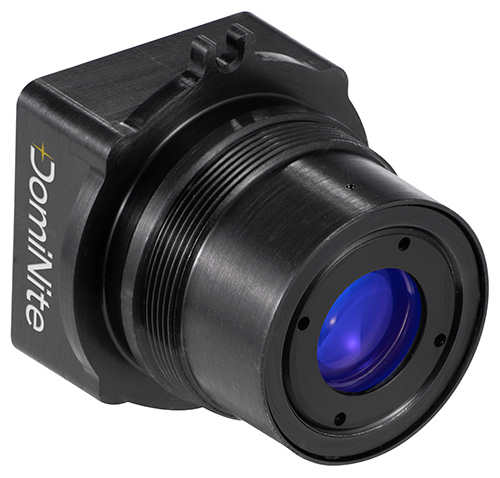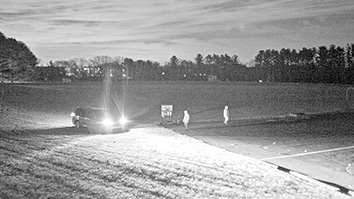
A new camera from SRI is poised to disrupt the decades-long dominance of analog low-light imaging.
Invented in the late 1940s, image intensifier tubes remain the gold standard for night vision. The technology has been relentlessly refined in recent decades, particularly by the United States military. Today, thanks to image intensifier tubes, American soldiers can operate safely and effectively in the darkest night-time conditions.
The challenge? Based on vacuum tube technology, image intensifiers are inherently analog. They can’t readily plug into emerging artificial intelligence (AI) and object recognition technologies, or sync with digital thermal imagers. Today’s best image intensifiers are also hard to make, somewhat fragile, and expensive.
One other meaningful limitation: image intensifiers perform exceptionally well in low-light conditions, but not in brighter conditions. If exposed to a sudden burst of light, they are easily blinded and even damaged.
“We believe that DomiNite is currently the most sensitive digital low-light imager that has been deployed in the field.” — Colin Earle
Since 2012, SRI has been collaborating with the Department of Defense to explore digital alternatives to analog night vision technology. That work has recently matured into a platform that is ready for deployment: the DomiNite camera. Smaller and less fragile than comparable analog I2 tubes in the market, DomiNite is poised to improve situational awareness for dismounted soldiers; enhance driver vision in ground vehicles; and provide superior intelligence, surveillance, and reconnaissance (ISR) capabilities for UAVs. In a commercial context, meanwhile, DomiNite is designed to bring new capabilities in areas like law enforcement, security, autonomous navigation, and outdoor recreation.
What makes DomiNite different?
“Lots of people claim to have digital night vision cameras, and some of them do a pretty good job,” says Colin Earle, director at SRI’s Center for Advanced Imaging. “But they just don’t have the low-light sensitivity that we have.”
Digital low-light cameras work because their sensors have much larger pixels and much lower noise than typical daytime cameras. When light is sparse, every photon matters. SRI’s approach to capture those photons is rooted in a patented “Quad Pixel” design. “This is the heart of the DomiNite system,” says Earle. The Quad Pixel design allows for two different modes. High-resolution mode operates well down to about “quarter-moon” conditions. When it gets even darker, for example in moonless or cloudy conditions, high-sensitivity mode automatically kicks in, providing the signal boost necessary for effective vision.

“Thanks to our Quad Pixel technology, we believe that DomiNite is currently the most sensitive digital low-light imager that has been deployed in the field,” Earle comments.
DomiNite is extremely light and small compared to night vision devices that rely on intensifier tubes, which means it is easily integrated into existing platforms. With DomiNite camera cores weighing less than half an ounce and cameras with an integrated lens consuming a volume of a little more than one cubic inch, they’re ideal for head-worn applications. DomiNite also provides a high dynamic range — crucial for diverse nighttime conditions. Unlike image intensifiers, it can simultaneously provide a clear image of bright and low-light areas and is not overwhelmed or damaged by light bursts.
Where DomiNite is headed
To extend the potential applications of digital low-light imaging, the team at the Center for Advanced Imaging is pursuing multiple paths that will enhance the DomiNite platform.
They continue to decrease the size, weight, and power (SWaP) of the camera, while also providing different configurations with a range of opto-mechanical and digital interfaces (USB, PoE, Camera Link). They have built reference designs demonstrating integration into binoculars and scopes, which will enable defense contractors and commercial customers to more quickly embed the camera into larger platforms.
Earle is particularly excited about color, given that the standard version of the camera is currently black-and-white. “When we first started this project,” he comments, “I didn’t think we were going to do very well on color.” That’s changing. The team is currently testing prototypes that deposit a microscopic color patch on one of the four receptors in each Quad Pixel. The results have been impressive and will provide even greater situational awareness at night.
Ultimately, Earle believes that AI may be the technology that truly takes digital low-light imaging to the next level, given the ease of connecting digital-native information with algorithmic processing. Working with a startup called Deepnight, the research team has begun processing video from DomiNite through an AI signal processing algorithm. With the algorithm, an image taken in dark “starlight” conditions becomes as clear as a non-processed image taken in ten-times-brighter “quarter-moon” conditions.
“When they add AI, it really pops,” says Earle. “In the 20th century, the analog image intensifier owned the night. In the 21st century, an AI-enhanced digital low-light sensor like DomiNite will own the night.”
To learn more about the DomiNite camera, visit DomiNite.sri.com.


